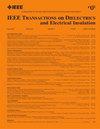高压电缆用无副产物交联聚乙烯共聚物共混物的优良直流电气性能
IF 2.9
3区 工程技术
Q2 ENGINEERING, ELECTRICAL & ELECTRONIC
IEEE Transactions on Dielectrics and Electrical Insulation
Pub Date : 2024-12-24
DOI:10.1109/TDEI.2024.3521874
引用次数: 0
摘要
用于高压电缆的交联聚乙烯(XLPE)的副产品降低了绝缘的纯度,从而限制了其直流电气性能。聚乙烯共聚物之间的无副产物点击化学反应显示出作为过氧化物交联替代品的巨大潜力。本文制备了聚乙烯共聚物共混物,并对其热性能、化学组成、晶体结构和介电特性进行了综合评价。选用低密度聚乙烯(LDPE)和由此产生的高压电缆用XLPE作为参考。此外,还探讨了抗氧剂对共混聚乙烯结构和性能的影响。结果表明,由于深阱密度较高,聚乙烯共聚物共混物具有优异的直流电性能。共聚物共混物中极性基团的掺入影响结晶的发展,导致结晶度降低和球晶尺寸减小。更重要的是,共聚物共混物中的极性基团显著增加了深阱的密度,抑制了空间电荷注入,提高了直流击穿强度。这些研究结果表明,这种新型绝缘材料在直流电缆绝缘领域具有广阔的应用前景。本文章由计算机程序翻译,如有差异,请以英文原文为准。
Excellent DC Electrical Performance of a Byproduct-Free Crosslinked Polyethylene Copolymer Blend for High-Voltage Cables
The byproducts of crosslinked polyethylene (XLPE) for high-voltage cables reduce the purity of the insulation, thereby limiting its dc electrical performance. The byproduct-free click chemistry reaction between polyethylene copolymers demonstrates significant potential as an alternative to peroxide crosslinking. In this article, polyethylene copolymer blends were prepared, and their thermal properties, chemical composition, crystalline structure, and dielectric characteristics were evaluated comprehensively. A low-density polyethylene (LDPE) and the resulting XLPE for high-voltage cables were selected as references. In addition, the effect of antioxidant on the structure and properties of polyethylene copolymer blends was explored. The results show that the polyethylene copolymer blends exhibit superior dc electrical performance owing to the higher density of deep traps. The incorporation of polar groups in the copolymer blends affects the development of crystallization, resulting in reduced crystallinity and diminished spherulite size. More importantly, the polar groups in the copolymer blends significantly increase the density of deep traps, which suppress the space charge injection and enhance the dc breakdown strength. These findings suggest that this novel insulating material holds promising prospects in the field of dc cable insulation.
求助全文
通过发布文献求助,成功后即可免费获取论文全文。
去求助
来源期刊
CiteScore
6.00
自引率
22.60%
发文量
309
审稿时长
5.2 months
期刊介绍:
Topics that are concerned with dielectric phenomena and measurements, with development and characterization of gaseous, vacuum, liquid and solid electrical insulating materials and systems; and with utilization of these materials in circuits and systems under condition of use.

 求助内容:
求助内容: 应助结果提醒方式:
应助结果提醒方式:


